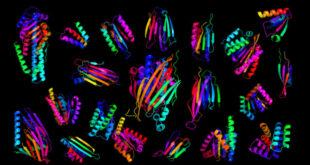A new pilot study, published in the journal Chemical Research in Toxicology, raises the possibility that humanity’s increasing use of titanium dioxide — the most common white pigment in everyday products — accounts for part of the global increase in the incidence of type 2 diabetes.
Inhaled and ingested titanium dioxide particles enter the bloodstream, are inflammatory and are phagocytized by macrophages and neutrophils. Image credit: Heller et al, doi: 10.1021/acs.chemrestox.8b00047.
In the mid-20th century, titanium dioxide (TiO2) replaced highly toxic lead-based pigments.
This compound became the most commonly used white pigment in paints and in foods, medications, toothpaste, cosmetics, plastics and paper. As a result, annual production of titanium dioxide has increased by 4 million tons since the 1960s.
Titanium dioxide is not a known constituent of any normal human tissue.
Human body normally has plenty of salts and compounds of metallic elements such as sodium, potassium, calcium, iron and magnesium, as well as lesser amounts of other metallic elements like cobalt or molybdenum but not of titanium.
“Our initial findings raise the possibility that type 2 diabetes could be a chronic crystal-associated inflammatory disease of the pancreas analogous to inflammatory lung diseases like silicosis and asbestosis,” said Professor Adam Heller, from the University of Texas, Austin.
In the pilot study, Professor Heller and co-authors examined 11 pancreas specimens, eight of which were from donors who had type 2 diabetes and three from donors who did not.
Whereas the three non-diabetic pancreatic tissue specimens contained no detectable crystals of titanium dioxide, the crystals were detected in all of the eight type 2 diabetes pancreatic tissue specimens.
“We show that particles comprising 110 nm average diameter titanium dioxide monocrystals abound in the type 2 diabetic pancreas, but not in the nondiabetic pancreas,” the researchers said.
“In the type 2 diabetic pancreas, the count of the crystals is as high as 108–109 per gram.”
“The increased use of titanium dioxide over the last five decades could be a factor in the type 2 diabetes epidemic,” Professor Heller said.
“The dominant type 2 diabetes-associated pancreatic particles consist of titanium dioxide crystals, which are used as a colorant in foods, medications and indoor wall paint, and they are transported to the pancreas in the bloodstream.”
“The study raises the possibility that humanity’s increasing use of titanium dioxide pigment accounts for part of the global increase in the incidence of type 2 diabetes.”
_____
Adam Heller et al. 2018. Association of Type 2 Diabetes with Submicron Titanium Dioxide Crystals in the Pancreas. Chem. Res. Toxicol 31 (6): 506-509; doi: 10.1021/acs.chemrestox.8b00047
 #Bizwhiznetwork.com Innovation ΛI |Technology News
#Bizwhiznetwork.com Innovation ΛI |Technology News




